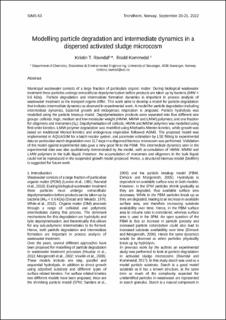| dc.contributor.author | Ravndal, Kristin Torgersen | |
| dc.contributor.author | Kommedal, Roald | |
| dc.date.accessioned | 2023-04-12T13:37:21Z | |
| dc.date.available | 2023-04-12T13:37:21Z | |
| dc.date.created | 2022-11-09T10:04:52Z | |
| dc.date.issued | 2022 | |
| dc.identifier.citation | Ravndal, K. T., Kommedal, R. (2022). Modelling particle degradation and intermediate dynamics in a dispersed activated sludge microcosm. Linköping Electronic Conference Proceedings 2022. | en_US |
| dc.identifier.issn | 1650-3686 | |
| dc.identifier.uri | https://hdl.handle.net/11250/3062715 | |
| dc.description.abstract | Municipal wastewater consists of a large fraction of particulate organic matter. During biological wastewater treatment these particles undergo extracellular depolymerisation before products are taken up by bacteria (MW < 0.6 kDa). Particle degradation and intermediate formation dynamics is important in process analysis of wastewater treatment as the transport regime differ. This work aims to develop a model for particle degradation that includes intermediate dynamics as observed in experimental work. A model for particle degradation including intermediate dynamics, bacterial growth and endogenous respiration is proposed. Particle hydrolysis was modelled using the particle breakup model. Depolymerisation products were separated into five different size groups: colloids; high, medium and low molecular weight (HMW, MMW and LMW) polymers; and one fraction for oligomers and monomers (SB). Depolymerisation of colloids, HMW and MMW polymers was modelled using first order kinetics. LMW polymer degradation was modelled using Michaelis-Menten kinetics, while growth was based on traditional Monod kinetics and endogenous respiration followed ASM3. The proposed model was implemented in AQUASIM for a batch reactor system, and parameter estimation by LSE fitting to experimental data on particulate starch degradation over 117 days in a dispersed biomass microcosm was performed. Validation of the model against experimental data gave a very good fit to the PBM. The intermediate dynamics seen in the experimental data was also qualitatively demonstrated by the model, with accumulation of HMW, MMW and LMW polymers in the bulk liquid. However, the accumulation of monomers and oligomers in the bulk liquid could not be reproduced in the suspended growth model proposed. Hence, a structured biomass model (biofilm) is suggested for future work. | en_US |
| dc.language.iso | eng | en_US |
| dc.publisher | Linköping University Electronic Press | en_US |
| dc.rights | Navngivelse 4.0 Internasjonal | * |
| dc.rights.uri | http://creativecommons.org/licenses/by/4.0/deed.no | * |
| dc.title | Modelling particle degradation and intermediate dynamics in a dispersed activated sludge microcosm | en_US |
| dc.type | Peer reviewed | en_US |
| dc.type | Journal article | en_US |
| dc.description.version | publishedVersion | en_US |
| dc.rights.holder | The authors | en_US |
| dc.subject.nsi | VDP::Teknologi: 500 | en_US |
| dc.source.pagenumber | 6 | en_US |
| dc.source.journal | Linköping Electronic Conference Proceedings | en_US |
| dc.identifier.doi | 10.3384/ecp192002 | |
| dc.identifier.cristin | 2071015 | |
| cristin.ispublished | true | |
| cristin.fulltext | original | |
| cristin.qualitycode | 1 | |

